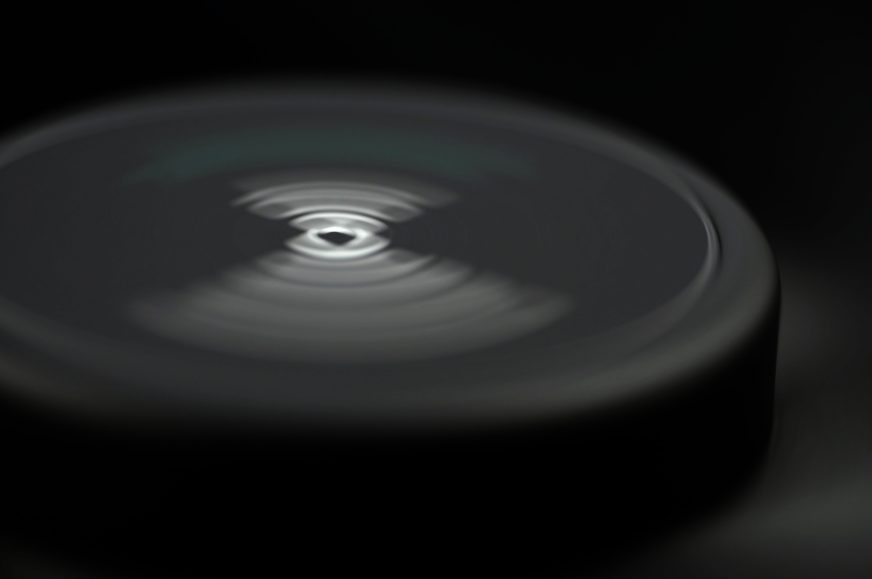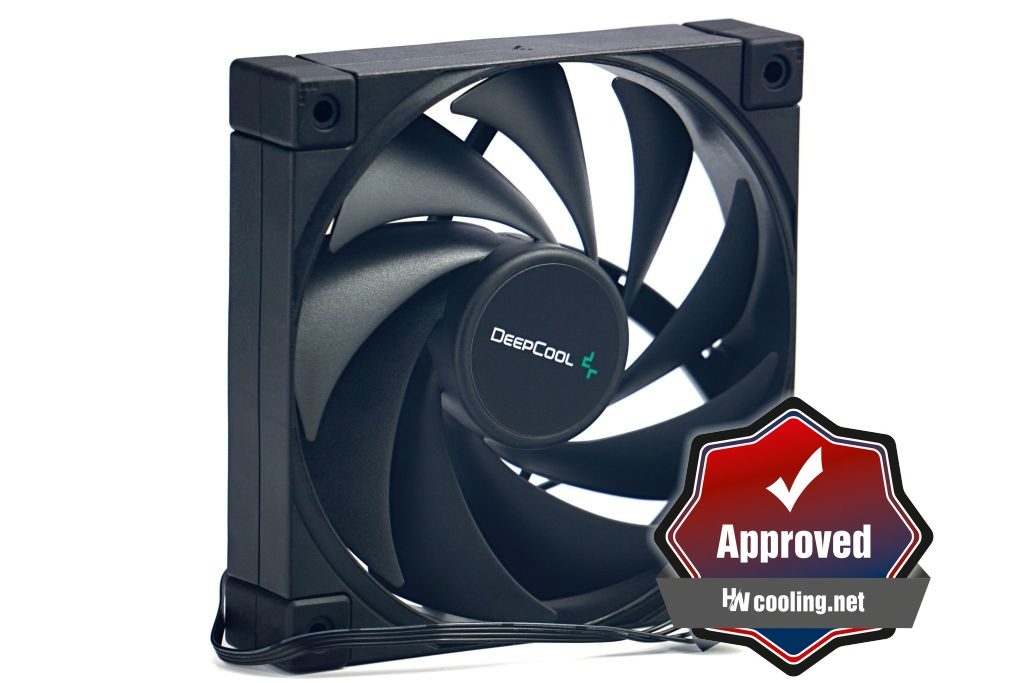Evaluation
It is made in the same injection mould as the FC120, but still has noticeably better properties. Stronger material, higher weight, different bearings and a more powerful motor make the FK120 one of the most attractive options among inexpensive fans. But that’s only assuming the “right” adjustment. Outside of that, this fan can be quite uncomfortable and ironically for the same reason it is sometimes unbeatable.
Evaluation
If you didn’t skip to the introductory chapter of the article breaking down the design details, you probably won’t be surprised by the fan’s superiority in tests with no obstacles. The only mode where the DeepCool FK120 is outperformed by another fan (the Arctic BioniX F120) is the “33 dBA” mode. In this speed range (around 900 rpm), what spoils it for the FK120 is a pronounced frequency spike in the sound at 247 Hz, characterized by a more rumbly response.
We don’t even have results with the grille in this mode (33 dBA) because it was not possible to adjust the fan. The closest noise level was roughly 0.5 dBA above or below. The FK120 fan gets into annoying resonant frequencies quite often. Outside of the standard modes, we also have the spectrograph at roughly 1250 rpm, which are the most critical – with a peak at 254 Hz with an intensity of as much as -54 dBu. Nobody wants a fan that sounds like that in their case, not even those who say they don’t care about the noise level of their computer.
What is interesting to note is that the resonant frequencies do not reflect too much on the fan vibration. Vibration is always low, lower than that of the FC120. It can be categorized as negligible, and even if you’ll definitely hear the fan, at least it won’t resonate the case, which would be a source of secondary noise.
But let’s not get away from the main point – the FK120 excels in its price class on all types of obstacles except a non-reinforced nylon filter. It collides with the latter because there is very little height difference between the frame and the fan hub which rubs against the mesh. On radiators, this fan usually follows closely behind the LCP fans (such as the MSI MEG Silent Gale P12 and the Noctua NF-A12x25 PWM), the BeQuiet! Silent Wings Pro 4 or the Nidec Servo Gentle Typhoon D1225C. This is also true in systems with high resistance environments, typically on cooler heatsinks with high-pressure cases.
At a price of 11 EUR with a top-notch price/performance ratio it is fair to mostly praise and even recommend the FK120 fan, but with a note “beware of resonant frequencies”, they are at every step, but as long as you tune the speed to some non-disturbing level at which they hold steady, the results will be worth it. Especially when you’re digging through cheaper fans. However, letting the speed be controlled dynamically depending on temperature can be wild (and acoustically unacceptable).
Regarding the speed, the range is wide, but the lower speed limit in the parameters (500 rpm) is a bit exaggerated or at least you have to reach for DC control. Despite the PWM you are always above 600 rpm. Some may miss the passive mode and although technically it is far from the perfect solution, the efficiency is perfect for the money and the DeepCool FK120 could be nice and quiet even at very low speeds. It’s not spoiled by bearings or a whirring motor, as is often the case in this price range.
English translation and edit by Jozef Dudáš
| DeepCool FK120 |
| + Suitable for every use |
| + Cooling efficiency (airflow/pressure per unit of noise) at a very high level |
| + Low price... |
| + … and a very attractive price/performance ratio |
| + Large and efficiently shaped blades given the cross-section... |
| + ... thanks to them, it achieves in some cases the best results in the tests |
| + High airflow even through the most restrictive obstacle |
| + Virtually noiseless operation of bearings and motor (no non-aerodynamic noises) |
| + Extra low, negligible vibrations |
| + Wide speed range |
| + Really powerful motor |
| - Often picks up unpleasant resonant frequencies (around 250 Hz) |
| - Higher minimum speed (~ 500 rpm) |
| - Does not support passive mode, does not "turn off" at low PWM intensity |
| - Collides with nylon dust filter |
| Approximate retail price: 11 EUR |
- Contents
- DeepCool FK120 in detail
- Basis of the methodology, the wind tunnel
- Mounting and vibration measurement
- Initial warm-up and speed recording
- Base 6 equal noise levels…
- ... and sound color (frequency characteristic)
- Static pressure measurement…
- … and airflow
- Everything changes with obstacles
- How we measure power draw and motor power
- Measuring the intensity (and power draw) of lighting
- Results: Speed
- Results: Airlow w/o obstacles
- Results: Airflow through a nylon filter
- Results: Airflow through a plastic filter
- Results: Airflow through a hexagonal grille
- Results: Airflow through a thinner radiator
- Results: Airflow through a thicker radiator
- Results: Static pressure w/o obstacles
- Results: Static pressure through a nylon filter
- Results: Static pressure through a plastic filter
- Results: Static pressure through a hexagonal grille
- Results: Static pressure through a thinner radiator
- Results: Static pressure through a thicker radiator
- Results: Static pressure, efficiency by orientation
- Reality vs. specifications
- Results: Frequency response of sound w/o obstacles
- Results: Frequency response of sound with a dust filter
- Results: Frequency response of sound with a hexagonal grille
- Results: Frequency response of sound with a radiator
- Results: Vibration, in total (3D vector length)
- Results: Vibration, X-axis
- Results: Vibration, Y-axis
- Results: Vibration, Z-axis
- Results: Power draw (and motor power)
- Results: Cooling performance per watt, airflow
- Results: Cooling performance per watt, static pressure
- Airflow per euro
- Static pressure per euro
- Results: Lighting – LED luminance and power draw
- Results: LED to motor power draw ratio
- Evaluation










Thank you so much for your hard work bringing us these reviews!
Greetings from Brazil!
Hello
Your expert explanation helped me make my final choice between the two DeepCool FK120 fans and the ASUS ROG Strix fan XF120.
The price difference of these two fans in Iran is insignificant and is around 5 dollars.
Overall, according to your tests, I would choose the Deep Cool fan.
I hope it is the right choice.
Your friend from Iran
Choosing the most suitable fan for a specific scenario is highly complex. In addition to the fact that all situations in practice are more or less different, each has a different set of priorities of individual characteristics. Someone may prefer lower vibrations to a slightly higher airflow, so that the fan does not end up being a source of excessive secondary noise in interaction with, for example, the case.
But when you have looked through our tests, taken a look at the context, evaluated the pros and cons, you must have made the right decision. 🙂
it would be more complex if we had more high quality fans on the market, but nowadays it’s mostly limited to whether you want maximum performance without noise or maximum performance disregarding the noise
in the first case you get A12x25 (or T30 if you have space for that), in the other probably some monster from Delta
if we had high quality fans optimized for specific usecases (like Noctua had in older generations, before releasing the overwhelmingly good A12x25) we could extend that choice to low vs high impedance, but nowadays S12A is entirely irrelevant and their static pressure fans are only used to save money